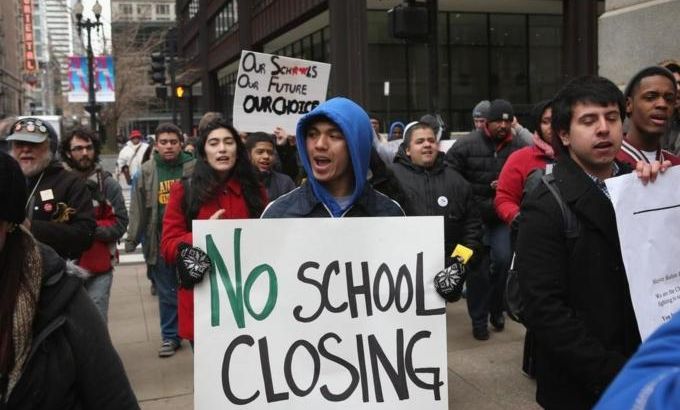
Cutting classes
As Chicago plans to close more than 50 schools, we ask what it means for the students who will be forced to relocate.
There is outrage in Chicago over plans to close more than 50 public schools – most of them in poor and minority neighbourhoods.
Chicago’s Mayor Rahm Emanuel says the closures are tough but necessary in order to deal with a $1bn deficit and what he called “underutilised” schools. He also says the change is necessary to provide students with a better education.
Keep reading
list of 4 items‘We share with rats’: Neglect, empty promises for S African hostel-dwellers
Thirty years waiting for a house: South Africa’s ‘backyard’ dwellers
Photos: Malnutrition threatens future Afghan generations
|
“These closings have been targeted at some of the most depressed and resource-starved communities … When you shut down schools in those communities, which are often the anchor of the communities, it increases the blight and a lot of the social problems in the community. So it is a big issue in terms of neighbourhood and community issues, aside from the educational problems it causes.“ – Michael Klonsky, Small Schools Workshop |
But an analysis by the Chicago Sun-Times shows that just one-third of students will be sent to schools that are deemed to be better-performing.
The majority of the school closures will be taking place in poor minority neighborhoods prompting critics, including the Chicago Teacher’s Union, to call the policy “classist and racist”.
While Chicago’s may be the largest wave of school closures in US history, it is not alone. The cities of Philadelphia, Detroit, Newark and Washington DC have all announced similar plans.
A study by the Pew Charitable Trust in 2011, which looked at school closures in six US cities, found that school districts end up saving less than had been predicted.
The city of Milwaukee expected to save $10m a year; so far they are saving around $6.5m a year.
Officials in Washington DC expected to save $23m a year, but ended up saving around $17m annually.
Kansas city, which did achieve substantial savings, did so by combining school closures with 700 layoffs.
Although Mayor Emanuel cites giving students a chance to leave poorly performing schools as one of the reasons for the closures in Chicago, the evidence shows little difference in educational attainment from such a policy.
|
“The point is that the schools have a fiduciary responsibility to provide education in a cost-effective way. And if they are not doing it in a cost-effective way – and I think that it’s fairly clear that that’s the case – then they have a responsibility to reallocate resources in a way that’s most effective.“ – Jason Richwine, an analyst at the Heritage Foundation |
A University of Chicago study focusing on schools closed between 2001 and 2006 found that only six percent of displaced students ended up in high-performing schools.
And 42 percent of students continued to attend schools with ‘very low’ achievement levels. A year after changing schools, students’ reading and math abilities were not any better or worse.
Students who did go to better-performing schools also had to travel an average of 6km to get there – which critics say risks the safety of students who have to go through neighbourhoods containing rival gangs.
So, what motivated the city’s decision and what does it mean for the tens of thousands of students who will be forced to relocate?
To discuss this, Inside Story Americas with presenter Shihab Rattansi is joined by guests: Michael Klonsky, the national director of the Small Schools Workshop – a consulting firm helping school districts create smaller learning institutions; Jitu Brown, an education organiser at the Kenwood Oakland Community organisation; and Jason Richwine, a senior analyst at the Heritage Foundation which specialises in education policy.
SCHOOL CLOSURES
- Chicago plans to close 54 public primary schools this year
- Closing of 54 public schools will affect 30,000 Chicago students
- The Chicago school closures will be the largest in US history
- City of Chicago says children from closing schools will be sent to better ones
- Chicago teachers union says closing schools will cost district $750m
- Other cities have announced plans to close schools this year
- Philadelphia officials have voted to close 23 schools this year
- Washington DC has proposed closing 15 schools this year
- Pew study: 1.7 million students now attend charter schools in the US
- Charter schools are publicly funded and independently operated schools
- National Education Association: US now has more than 3,000 charter schools